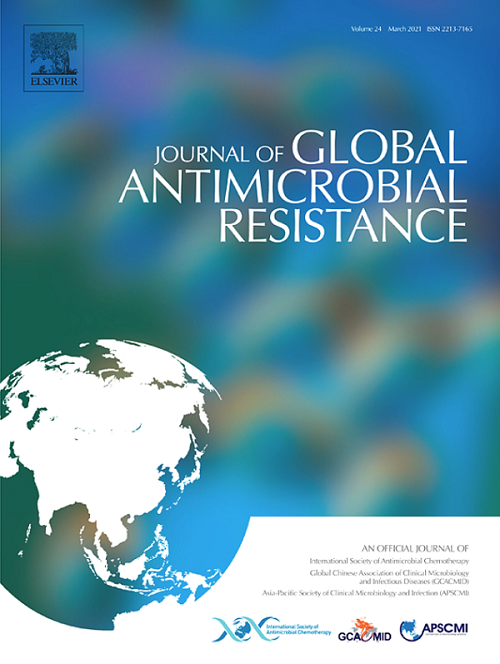Isolation and characterization of Acinetobacter phage vAbaIN10 active against carbapenem-resistant Acinetobacter baumannii (CRAB) isolates from healthcare-associated infections in Dakar, Senegal
IF 3.2
3区 医学
Q2 INFECTIOUS DISEASES
引用次数: 0
Abstract
Background
Carbapenem-resistant Acinetobacter baumannii (CRAB) is a critical antimicrobial resistance threat and a WHO-prioritized pathogen. With intrinsic resistance to multiple antibiotics and the emergence of pan-resistant isolates, CRAB infections are challenging to treat, often relying on polymyxins, tigecycline, aminoglycosides, or combinations, though co-resistance is rising globally. Phage therapy is considered as a potential treatment for multidrug-resistant A. baumannii. This study focused on isolating and characterizing phages active against CRAB strains from healthcare-associated infections in Dakar, Senegal.
Methods
A lytic phage, Acinetobacter vAbaIN10, was isolated from wastewater collected at the Aristide Le Dantec Hospital in Dakar, Senegal. Isolation, host range, efficiency of plating, temperature and pH stability, lysis kinetics, one-step growth test, sequencing, and genomic analysis were performed.
Results
Phage vAbaIN10 belongs to the class Caudoviricetes and the genus Friunavirus. Its genome is 40,279 bp in size. Phage vAbaIN10 is stable across a wide pH range (3–9) and temperature range (25°C–60°C). The phage's lytic activity was evaluated at different multiplicities of infection (MOI): MOI 10, 1, and 10⁻¹. All MOIs significantly reduced the growth of host bacteria. The one-step growth curve showed that vAbaIN10 had a latency period of 25 min and a burst size of approximately 4.78 × 10³ phages per infected bacterial cell. No tRNA, mtRNA, clustered regularly interspaced short palindromic repeat, virulence factors, or antibiotic resistance genes were found in the genome.
Conclusions
The biological and genomic characteristics of vAbaIN10 meet the requirements for its potential use in phage therapy.
塞内加尔达喀尔卫生保健相关感染中抗耐碳青霉烯类鲍曼不动杆菌(CRAB)不动杆菌噬菌体vAbaIN10的分离和鉴定
背景:鲍曼不动杆菌,特别是碳青霉烯耐药菌株(CRAB),在抗微生物药物耐药性(AMR)的斗争中引起了主要关注,被世界卫生组织(WHO)确定为最优先的病原体。鲍曼不动杆菌对包括青霉素、头孢菌素、氯霉素和磷霉素在内的几种抗生素具有内在耐药性,但抗菌素耐药性的发展导致了极端耐药和泛耐药菌株的出现。螃蟹感染的治疗通常依赖于多粘菌素、替加环素、氨基糖苷及其联合治疗。然而,在世界范围内,对这些抗生素的共同耐药的报道越来越多。噬菌体疗法现在正被重新考虑作为一种有希望的方法来治疗由耐多药鲍曼不动杆菌引起的感染,特别是那些带来治疗挑战的感染。方法:从塞内加尔达喀尔Aristide Le Dantec医院收集的废水中分离出一种裂解噬菌体vAbaIN10不动杆菌。进行了分离、寄主范围、电镀效率(EOP)、温度和pH稳定性、裂解动力学、一步生长试验、测序和基因组分析。结果:噬菌体vAbaIN10属于尾状病毒纲和弗里纳病毒属。其基因组的大小为40279 bp。噬菌体vAbaIN10在很宽的pH范围(3至9)和温度范围(25°C至60°C)内都是稳定的。在不同的感染倍数(MOI)下评估噬菌体的裂解活性:MOI 10、1和10毒血症。所有MOIs均显著降低了宿主细菌的生长。一步生长曲线显示,vAbaIN10的潜伏期为25分钟,每个感染细菌细胞的爆发大小约为4.78 × 10³噬菌体。基因组中未发现tRNA、mtRNA、CRISPR、毒力因子或抗生素耐药基因。结论:vAbaIN10的生物学和基因组学特性满足其在噬菌体治疗中的潜在应用要求。
本文章由计算机程序翻译,如有差异,请以英文原文为准。
求助全文
约1分钟内获得全文
求助全文
来源期刊

Journal of global antimicrobial resistance
INFECTIOUS DISEASES-PHARMACOLOGY & PHARMACY
CiteScore
8.70
自引率
2.20%
发文量
285
审稿时长
34 weeks
期刊介绍:
The Journal of Global Antimicrobial Resistance (JGAR) is a quarterly online journal run by an international Editorial Board that focuses on the global spread of antibiotic-resistant microbes.
JGAR is a dedicated journal for all professionals working in research, health care, the environment and animal infection control, aiming to track the resistance threat worldwide and provides a single voice devoted to antimicrobial resistance (AMR).
Featuring peer-reviewed and up to date research articles, reviews, short notes and hot topics JGAR covers the key topics related to antibacterial, antiviral, antifungal and antiparasitic resistance.
 求助内容:
求助内容: 应助结果提醒方式:
应助结果提醒方式:


